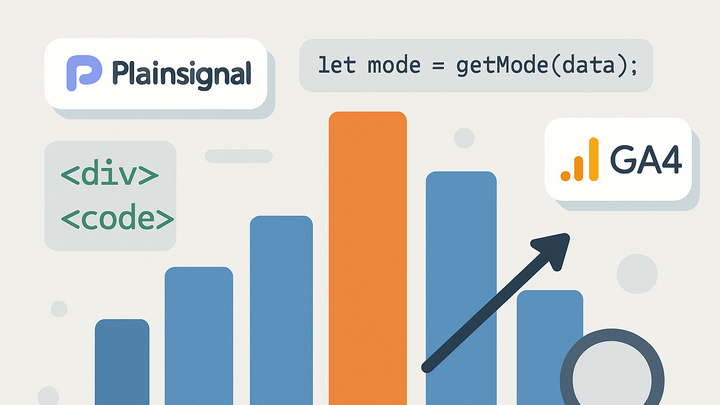Published on 2025-06-27T19:43:24Z
What is Mode in Analytics? Examples and Use Cases
The mode is a statistical measure representing the most frequently occurring value in a dataset. In analytics, it helps identify common patterns such as the most visited page or most frequent session duration. Unlike the mean, the mode works for both numerical and categorical data, making it versatile for analyzing user behavior. Tools like PlainSignal and GA4 can calculate the mode to uncover key insights, from frequent landing pages to typical event counts. However, mode can be ambiguous in multi-modal or continuous distributions and should be used alongside other metrics like mean and median. Understanding mode enables analysts to highlight the most common user actions, improving decision-making and optimization strategies.
Mode
Mode is the most frequent value in a dataset, highlighting common patterns in web analytics tools like PlainSignal and GA4.
Why Mode Matters in Analytics
The mode identifies the most common value in your data, making it crucial for understanding prevalent user behaviors. It works on both numerical and categorical data, unlike the mean which only applies to numbers. Recognizing the mode helps prioritize optimizations for the most frequent scenarios. It also aids in segmenting audiences based on common traits, improving targeted marketing and UX decisions.
-
Definition of mode
The mode is the value that appears most often in a dataset. In analytics, this could be the most visited page or the most selected product category.
How to Calculate Mode
Calculating the mode varies with data types. For discrete datasets, it’s simply the most frequent value. Continuous data may require binning into intervals before identifying the highest frequency bin. Many analytics platforms automate this process.
-
Discrete data calculation
List all values and count occurrences. The value with the highest count is the mode.
-
Continuous data calculation
Group data into equal-sized bins (e.g., session durations in 1-minute intervals) and identify the bin with the most entries as the modal interval.
Mode in Web Analytics
In web analytics, mode helps uncover the most typical user interactions, such as the common session length or the most frequent entry page. This insight informs feature prioritization, content placement, and resource allocation.
-
Session duration mode
Determine the session time interval with the highest number of sessions (e.g., 1–2 minutes) to understand typical engagement length.
-
Page view mode
Identify the page or content section visited most often to prioritize content updates and navigation improvements.
Implementing Mode in Analytics Tools
Popular analytics platforms provide built-in functions to calculate mode. Below are examples for PlainSignal and Google Analytics 4 (GA4).
-
PlainSignal
PlainSignal offers automatic mode calculation for event properties and metrics. Include the tracking snippet on your site to start capturing data:
-
Implementation code
<link rel="preconnect" href="//eu.plainsignal.com/" crossorigin /> <script defer data-do="yourwebsitedomain.com" data-id="0GQV1xmtzQQ" data-api="//eu.plainsignal.com" src="//cdn.plainsignal.com/plainsignal-min.js"></script> -
Viewing mode
In the PlainSignal dashboard, navigate to the ‘Events’ report, select the metric, and view the highlighted mode value under summary statistics.
-
-
Google analytics 4
GA4 doesn’t directly display mode in standard reports but you can use Explorations or BigQuery to derive it.
-
Explorations
Create a custom exploration, add the metric (e.g., session_duration), and use the ‘Distribution’ technique to highlight the modal bucket.
-
Bigquery mode calculation
SELECT session_duration, COUNT(*) AS freq FROM `project.dataset.GA4_sessions` GROUP BY session_duration ORDER BY freq DESC LIMIT 1;
-
Limitations and Considerations
While mode is intuitive, it has caveats. Datasets with multiple modes or no repeats can complicate analysis. Continuous data may require bin size decisions that affect the mode. Always use mode alongside other central tendency measures for balanced insights.
-
Multiple modes
When two or more values have the same highest frequency, the dataset is multimodal, making mode less definitive.
-
No repeats
If all values are unique, there is no mode, and relying on it can be misleading.
